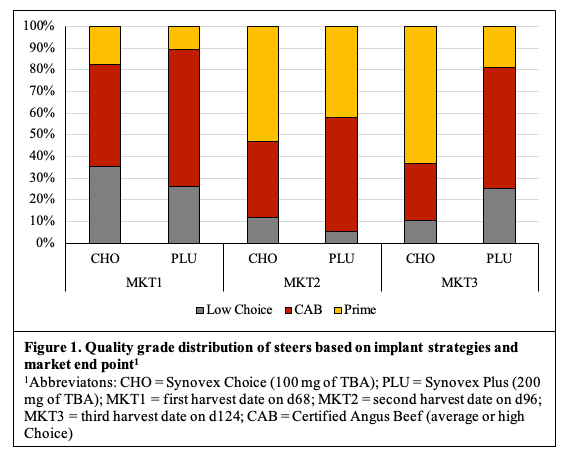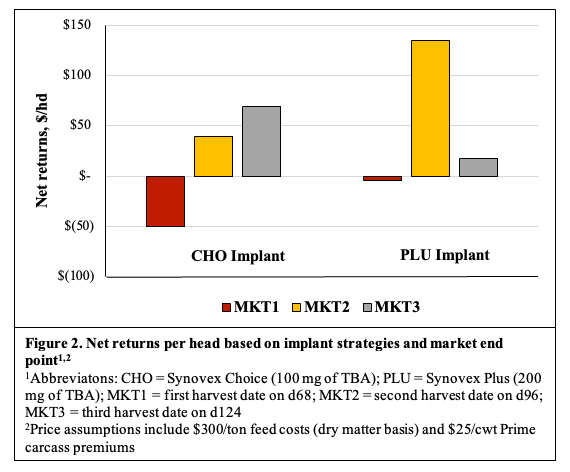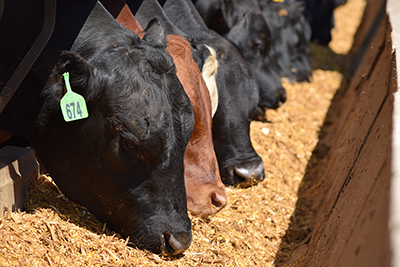Growing Beef Newsletter
May 2024, Volume 14, Issue 11
Effects of market timing and performance technologies on marketing decisions for high quality beef (Progressive Cattle article)
Erika Lundy-Woolfolk, ISU extension beef specialist
To maximize carcass quality, cattle are often fed longer at the expense of reduced performance and higher cost of gain. Therefore, there is a need to evaluate the tradeoffs related to days on feed and market timing contingent on feed costs and grid premiums/discounts for high quality cattle sold on a carcass or grid market basis.
One hundred and eight Angus steers (826 lbs.) were utilized in a study at the ISU Armstrong Research Farm near Lewis looking at the impact of two implant strategies (CHO = moderate potency implant vs. PLU = high potency implant) and various harvest dates resulting in differing backfat endpoints. Steers fed a common finishing diet with carcass ultrasound utilized to track external and internal fat deposition. Utilizing initial body weights and carcass ultrasound data as well as age and parentage information, steers were randomly assigned to implant and harvest dates at the start of the trial.
The first marketing group was set for harvest on day 68 when the group average had an ultrasound estimated 12th rib backfat thickness of 0.5 inches (MKT1). The second and third marketing groups were also scheduled at the same time as MKT1 for day 96 (MKT2) and 124 (MKT3) respectively.
While implant did not impact ribeye area (REA), steers implanted with CHO continued to build internal fat deposition with each marketing date. However, carcass intramuscular fat of PLU-implanted steers leveled off after MKT1 and resulted in steers harvested on MKT3 having lower marbling scores than those marketed on MKT2. The most likely driver of this is the unexpected poorer ADG (0.64 lbs./hd) of PLU-implanted X MKT3 steers compared to other marketing groups of the same implant.
Intake was not impacted by implant or marketing date. Steers that received the higher potency PLU implant tended to have improved feed conversion compared to CHO-implanted steers (6.32 vs. 6.81 lbs. of feed per lb. of gain) and heavier hot carcass weights. Results of this study suggest that higher potency implants do result in added growth performance benefits but did slightly hinder carcass quality compared to a moderate potency implant (Figure 1).

With today’s average feed prices ($300/ton, dry matter basis) and high Prime premiums ($25/cwt), feeding cattle longer results in greater returns per head (Figure 2). For the CHO-implanted steers, there was nearly a $120/hd spread amongst the three marketing dates, largely driven by the increase in Prime carcasses from 18% on MKT1 to 70% on MKT3. For the PLU-implanted steers, MKT2 was substantially more profitable due to exceptional growth performance and 42% of the steers grading Prime. However, those returns were lost by the MKT3 due to reduced growth and carcass performance.

In scenarios with higher feed prices, there are narrow margins for feeding cattle regardless of grid premiums, but marketing cattle at interim weights return the least amount of losses. With lower feed costs, feeding cattle with high-quality carcass genetics to heavier weights increases profit potential.
*This research was funded by the Iowa State Beef Checkoff. Iowa State University Extension and Outreach personnel involved in the project are Garland Dahlke, Matt Groves, Dan Loy, Erika Lundy-Woolfolk, Beth Reynolds, and Patrick Wall.
This monthly newsletter is free and provides timely information on topics that matter most to Iowa beef producers. You’re welcome to use information and articles from the newsletter - simply credit Iowa Beef Center.

